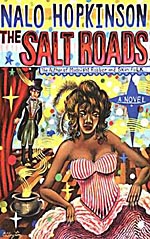
![]() Rhondak101
Rhondak101
9/26/2014
![]()
One of the things that I dislike about some of the challenges that I'm participating in is that they require a review of every single book. Sometimes when I finish a book, I don't want to write about it. Sometimes this is because I really disliked the book or the author (but know that others love them) Why should I rain on their parade? For example, years ago I wrote a scathing review of Jack Vance's The Dying Earth and Eyes of the Overworld , but I never posted them. On the opposite side, sometimes I love a book so much that I don't want to ruin the magic by trying to explain it. Earlier this year, I felt this way about Among Others. And finally, sometimes, I feel that I have nothing substantive to say.
That's the way that I feel about Nalo Hopkinson's The Salt Roads. I liked it, but I didn't like it as much as I had hoped and I feel that I have nothing to say about it that you can't learn from the blurb. Some readers will have trouble with the premise: the emotions and prayers of three slave women in 17th century St. Dominique connect the spirit of the stillborn baby they are burying to the consciousness of the goddess Lasirén (sometimes called Enzili). They somehow send this combined consciousness into the body of Jeanne, the mistress of 19th century French poet Charles Baudelaire. Lasirén lives like a parasite in Jeanne but finally learns to jump to the lives of other women as well. One of them is Thais, the 4th-century prostitute later canonized as St. Mary of Egypt. The other is Mer, the slave-midwife who delivered the stillborn baby. This set up is the problem that most reviewers note: Why does Lasirén move to the slave women's future instead of their past? Why these particular women? She uses her title The Salt Roads within the narrative to provide a bit of a connection, but it is quite tenuous.
However, once I decided to ignore the problems of internal logic, I enjoyed what I learned from the book, which is clearly very carefully researched. The St. Dominique sections were fascinating and incorporated a lot of Caribbean culture that I hadn't read about before. The Jeanne sections, which make up the most of the book get very tiresome, mostly because Jeanne and Charles are tiresome characters. The Mary sections begin to appear at the end and get short shrift because of this, in my opinion. Her sections feel very rushed, and I would have liked to see much more about her. Despite some disappointments, I will read certainly more by Nalo Hopkinson.